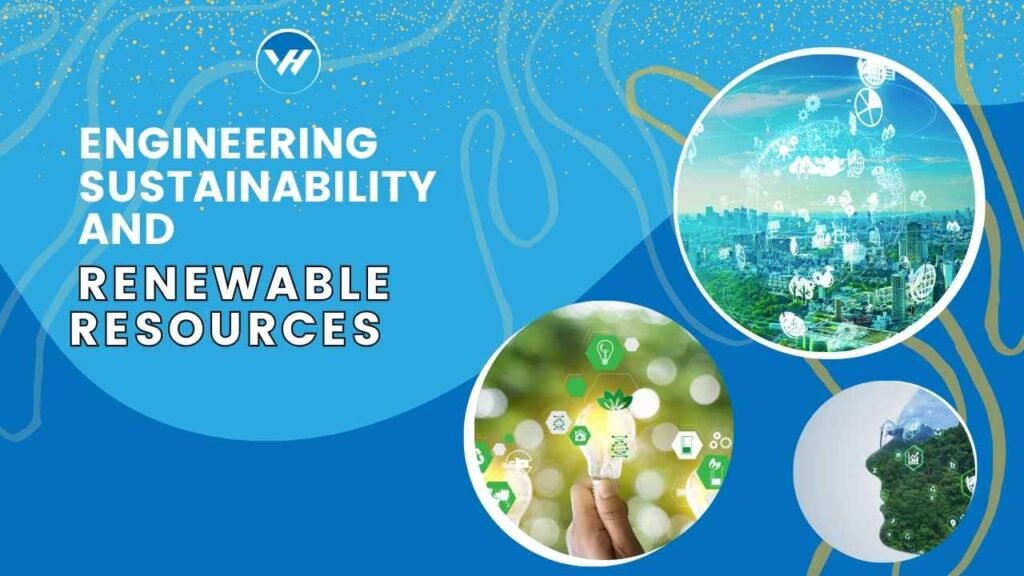Hey there! Have you ever thought about how crucial sustainability is in engineering? Imagine living in a world where energy is clean, renewable, and doesn’t harm our planet. That’s the dream, right? Well, with renewable resources, that dream is becoming a reality. In this article, we’re diving deep into the fascinating world of engineering sustainability and renewable resources. Buckle up, because we’re about to embark on a green journey!

Table of Contents
ToggleUnderstanding Sustainability in Engineering
So, what’s this whole sustainability thing about? In simple terms, sustainability in engineering means creating systems and processes that are not only efficient but also kind to our environment. It’s about making sure we meet our current needs without compromising the ability of future generations to meet theirs. Pretty cool, huh?
Now, why should we care? Well, sustainable engineering practices come with a boatload of benefits. They reduce waste, save energy, and help preserve our natural resources. Plus, they often lead to innovative solutions that can be more cost-effective in the long run. It’s a win-win!
Types of Renewable Resources
Let’s talk about the stars of the show: renewable resources. These are natural resources that can be replenished over time. We’ve got a few big players in this category:
- Solar Energy
- Wind Energy
- Hydropower
- Biomass Energy
- Geothermal Energy
Each of these has its own unique way of harnessing nature’s power, and we’re going to explore them all.
Solar Energy
First up, solar energy. Have you seen those shiny panels on rooftops? Those are solar panels, and they’re pretty amazing. They capture sunlight and convert it into electricity. How do they do it? Through photovoltaic cells that generate electric current when exposed to sunlight.
Solar energy has a ton of advantages. It’s abundant, renewable, and produces no pollution. But, it does have some challenges, like the need for large areas for panels and the fact that it doesn’t work at night. Despite these, solar energy is being used in everything from powering homes to running massive solar farms.
Solar panels are getting more efficient every year. Advances in materials and technology mean that newer panels can convert more sunlight into electricity than ever before. Some even work in low-light conditions! Plus, solar energy can be stored in batteries for use when the sun isn’t shining. This makes solar power a versatile and reliable source of renewable energy.
Wind Energy
Next, let’s talk about wind energy. Picture those huge wind turbines you see in open fields. These turbines convert the kinetic energy from the wind into mechanical power, which is then turned into electricity.
Wind energy is fantastic because it’s clean and plentiful. However, it can be intermittent – after all, the wind doesn’t always blow when you need it to. But engineers are coming up with creative solutions to store and distribute wind-generated electricity efficiently.
Offshore wind farms are becoming increasingly popular. These are wind turbines located in bodies of water where winds are stronger and more consistent than on land. Offshore wind farms can generate a lot of power and have less impact on landscapes and wildlife compared to onshore wind farms.
Hydropower
Hydropower has been around for a long time. It uses the energy from flowing water to generate electricity. Hydropower plants usually involve dams, which can have significant environmental impacts. But new innovations are making hydropower more sustainable and less disruptive to local ecosystems.
Small-scale hydropower systems, also known as micro-hydro systems, are an exciting development. These systems can generate electricity without the need for large dams, making them more environmentally friendly. They’re perfect for remote areas and communities that are off the grid.
Biomass Energy
Biomass energy is all about converting organic materials like plant and animal waste into usable energy. This can be done through processes like combustion or fermentation. It’s renewable and helps reduce waste, but it can be resource-intensive to produce on a large scale.
Bioenergy projects are popping up all over the world. From turning agricultural waste into biofuels to creating biogas from organic waste, biomass energy is a versatile and sustainable energy source. It’s also an excellent way to manage waste and reduce greenhouse gas emissions.
Geothermal Energy
Geothermal energy taps into the heat stored beneath the Earth’s surface. By drilling into geothermal reservoirs, we can harness this heat to produce electricity and heat buildings. It’s a stable and reliable source of energy, though it’s location-specific and can be costly to develop.
Enhanced Geothermal Systems (EGS) are a game-changer. These systems can create geothermal energy resources in areas where natural geothermal activity is low. By injecting water into hot rock formations, EGS can generate a continuous supply of geothermal energy, making it more widely available.
Integrating Renewable Resources in Engineering Projects
Integrating these renewable resources into engineering projects isn’t always straightforward. There are challenges like storage, distribution, and initial costs. But there are also incredible success stories, like cities powered entirely by renewable energy and innovative technologies that make renewables more accessible.
Smart grids are a revolutionary concept in the energy sector. They use digital technology to monitor and manage electricity flows, making it easier to integrate renewable energy sources. Smart grids can balance supply and demand, reduce energy waste, and enhance the reliability of the power supply.
The future looks bright, with trends pointing towards even more efficient and widespread use of renewable resources. Engineers are at the forefront, finding ways to overcome obstacles and make sustainable energy a reality.
Role of Engineers in Promoting Sustainability
Engineers are the unsung heroes in the quest for sustainability. They’re the ones designing, building, and maintaining systems that use renewable resources. They’re also advocates for sustainable practices, pushing for changes in how we approach energy use and conservation.
Ethically, engineers have a responsibility to consider the environmental impact of their projects. It’s about leaving the world a better place than we found it, and that’s a pretty noble goal.
Professional organizations like the American Society of Civil Engineers (ASCE) and the Institute of Electrical and Electronics Engineers (IEEE) are promoting sustainability in engineering. They provide guidelines, resources, and training to help engineers incorporate sustainable practices into their work.
Education and Training for Sustainable Engineering
To be effective, engineers need the right education and training. That’s why many engineering programs are now including sustainability in their curriculum. There are also professional development opportunities to keep skills sharp and up-to-date with the latest sustainable practices.
Universities are offering specialized courses and degrees in sustainable engineering. These programs cover topics like renewable energy systems, environmental impact assessment, and sustainable design principles. They prepare engineers to tackle the challenges of creating a sustainable future.
Policy and Regulation
Government policies play a huge role in promoting renewable energy. From tax incentives to regulations mandating the use of renewable resources, these policies help drive the transition towards sustainability. International agreements and standards also set the stage for global cooperation in tackling climate change.
Policies like the Paris Agreement and the United Nations Sustainable Development Goals (SDGs) are pushing countries to adopt renewable energy and reduce carbon emissions. These frameworks encourage collaboration and innovation in the renewable energy sector.
Virtual Help for Engineering Students
Now, let’s talk about Virtual Help, your go-to platform for finding tutors and getting assignment help. Whether you’re tackling a project on renewable energy or need help with your engineering coursework, Virtual Help has got your back. The app makes it easy to connect with experts and get the assistance you need to succeed.
Virtual Help offers a range of features to support engineering students. You can find tutors who specialize in renewable energy, get help with homework and assignments, and even access resources and study materials. The app is user-friendly and available on both iOS and Android, making it convenient for students everywhere.
Future of Renewable Resources in Engineering
The future is bright for renewable resources in engineering. Emerging technologies are making renewables more efficient and accessible. Innovations like advanced energy storage systems, smart grids, and next-generation solar panels are just the beginning.
Predictions for the next decade include a significant increase in the use of renewable energy, a decline in fossil fuel consumption, and more sustainable engineering practices. Engineers will continue to play a crucial role in driving these changes and shaping a sustainable future.
Conclusion
So, there you have it – a deep dive into the world of engineering sustainability and renewable resources. From solar panels to wind turbines, engineers are making incredible strides in creating a greener, more sustainable world. With the right education, policies, and innovative spirit, the future of renewable energy looks incredibly promising.
FAQs
- What are the main types of renewable resources?
- Solar energy, wind energy, hydropower, biomass energy, and geothermal energy are the primary types of renewable resources.
- How can engineers contribute to sustainability?
- Engineers can design and implement systems that use renewable resources, advocate for sustainable practices, and innovate new technologies to reduce environmental impact.
- What is the biggest challenge in using renewable resources?
- Some of the main challenges include storage, distribution, and initial costs, as well as the intermittent nature of resources like wind and solar energy.
- How does Virtual Help support engineering students?
- Virtual Help provides access to expert tutors, assignment help, and study resources, making it easier for engineering students to succeed in their coursework and projects.
- What is the future of renewable energy in engineering?
- The future looks bright with emerging technologies making renewable energy more efficient and accessible. Engineers will continue to play a vital role in driving sustainable practices and innovations.





